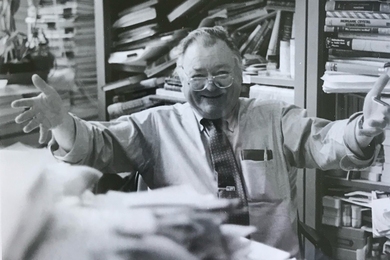Fifty-three MIT faculty, staff, students and organizations received awards and words of praise at the annual Awards Convocation held May 13.
The Karl Taylor Compton Prize, which is awarded to a student who promotes high standards of achievement and good citizenship within the MIT community, was presented to John S. Hollywood of Crofton, MD, a senior in mathematics. Rosalind H. Williams, dean of undergraduate education, cited Mr. Hollywood for his accomplishments, including his electronic newsletter Institute. "I was startled by how it was at once brief, perceptive and very, very well informed," she said. She also noted Mr. Hollywood's work as a member of the Student Services reengineering advisory committee which led to surveys and committees on housing and food, and as chair of the Undergraduate Committee on Student Life. He was "instrumental" in creating the Student Resources Service, which provides training for students to assist other students in finding problem-solving resources, Dean Williams said.
----------
The William L. Stewart, Jr. Awards for outstanding contributions to extracurricular activities went to Carlos Inaki Gutierrez, a senior in mechanical engineering from Puebla, Mexico, and Club Mex; Albert I. Hsu, a senior in materials science and engineering from Timonium, MD; Anthony J. Ives, a senior in urban studies and planning from Waterloo, IA; Joseph M. Lee, a junior in chemistry from Warminster, PA; Berdell Knowles Jr., a senior in mathematics from Gainesville, FL; Dhaya Lakshminarayanan, a senior in urban studies and planning from Roswell, GA; and Shruti Sehra, a senior in chemistry from
Scottsdale, AZ.
Mr. Gutierrez was recognized for "bringing energy, class and solid achievement" to Club Mex, which organized events featuring speakers including MIT Nobel laureate Mario Molina and Harvard President Neil Rudenstine. His work "brought a fresh blast of ideas to Club Mex and to MIT as a community," according to a nominating paper read by presenter Andrew M. Eisenmann, associate dean for undergraduate education and student affairs.
Mr. Hsu was lauded for the time and energy he devoted to saving Baker Dining Hall, "maintaining a visible presence as an activist for the preservation of an integral part of Baker House." His efforts "went above and beyond the call of duty in service of [his] fellow students," Mr. Eisenmann said.
Mr. Ives "demonstrated compassion for his fellow students and helping others" in his various activities, which included service as undergraduate representative on the Student Services reengineering team, president and rush chair of his fraternity, and in LINKS. He also organized a trip to Washington, DC, over spring break where MIT students tutored in city schools. "By single-handedly redefining spring break, he brought honor and recognition to MIT," Mr. Eisenmann said.
For his work with the National Society of Black Engineers at MIT, the Black Student Union and Kappa Delta Psi, particularly in producing publications such as The Torch for BSU and Spirit for the Office of Minority Education, Mr. Knowles was acknowledged "for the dedication he has shown to the MIT community."
Ms. Lakshminarayanan was praised as a "dynamic and highly visible leader" as one who organized events in a variety of East Campus posts. "Your dedication to the Dormitory Council provided your successors with a strong base to move forward," Mr. Eisenmann said.
Mr. Lee organized the Interfraternity Council's new-member retreat, for which he was praised by a student nominator for "his vision and contribution to our freshman class, as well as the whole IFC."
Ms. Sehra was recognized for her "devotion to community service, both individually and through organizations," which included LINKS, Sigma Kappa, the Panhellenic Council, and as organizer of CityDays.
----------
The Gordon Y Billard Award for special service of outstanding merit for the Institute was given to John M. Fresina, director of the Safety Office, and Robert M. Randolph, senior associate dean for undergraduate education and student affairs. For more than 30 years, Mr. Fresina has been an "ever-tenacious watchdog over changing legislation and regulations," President Charles M. Vest said in reading the citation. "You have approached your mission as an educator rather than an enforcer and in doing so, you've been a teacher to us all."
President Vest paid tribute to Dean Randolph's service "as a wise counsel and advisor to students at all levels, I might add including the president." He has overseen the chaplaincy and the creation of the Religious Life Center, "maintaining a keen sense of humor and an abiding optimism perhaps best demonstrated in his unshaken loyalty over the years to the Boston Red Sox," President Vest quipped. "In times of confusion, you speak for the common good; in times of conflict, you mediate and connect, and in times of crisis, you offer caring and comfort."
----------
Patricia E. Gavagan, administrator in the Department of Materials Science and Engineering, was presented with the James N. Murphy Award, given to an employee "whose spirited contributions to the Institute family have won a place in the hearts of students." A faculty nominator told of her work "as a critical interface between students and staff with a spirit and attitude which is unusual and wonderful." Student nominators decribed her as a "savior," and she was also cited as "a first and last aid to countless students on the road to graduation and is an equally constant resource to faculty. she has been an unsung hero for way too many years."
----------
The Edward L. Horton Fellowship Award was presented by the Graduate Student Council to the European Club for its "energy and enthusiasm for organizing events both on and off campus" and maintaining a strong presence in other campus organizations such as the International Scholars and Graduate Student Council. The club "has truly added to the quality of graduate student life at MIT," said presenter Barbara J. Souter of the GSC, a graduate student in earth, atmospheric and planetary sciences.
----------
Judith Tendler, professor of political economy in the Department of Urban Studies and Planning, was the winner of the Irwin Sizer Award for the Most Significant Improvement in MIT Education. She was praised "not only for the high quality of the classes she teaches at MIT, but in particular, her fieldwork-based research courses she initiated and oversees in developing countries," Ms. Souter said. Student nominators cited her courses as "one of the most formative and educational experiences in their time at MIT."
----------
The first-ever Frank E. Perkins Award, established by the GSC in honor of the dean of the graduate school from 1983-95 to honor a professor "who has served as an excellent advisor and mentor" to students, was given to Associate Professor James E. Chung of electrical engineering and computer science, and Lionel C. Kimerling, Thomas Lord Professor of Materials Science and Engineering. Students praised Professor Chung as "an effective mentor at both professional and personal levels. [whose] approach hits the right balance between giving independence to students and giving close guidance." For Professor Kimerling, according to nominators, "students' personal and professional growth, not his own research agenda, is his first priority."
------------
Two new awards were given starting this year in memory of Kristen E. Finnegan, a graduate student in architecture and instructor in the Writing Program who died a year ago. The Kristen E. Finnegan Prize, which recognizes the contribution of a graduate student in helping undergraduates improve their writing skills, was presented to John Matthew Carpenter of urban studies and planning. The key to his success as a teaching assistant and fellow in the Writing Initiative is his "willingness to go the extra mile for students outside of class as well as in," said presenter Rosalind Williams, who is also the Metcalfe Professor of Writing.
The Kristen Ellen Finnegan Memorial Award in the History, Theory and Criticism of Architecture was established by contributions from Ms. Finnegan's friends and family and is given to a female student from the United States or Canada in the third year of a doctoral program. Annie Pedret "is not only highly deserving but will carry the personal memory of Kristen Finnegan," while Sarah M. Whiting "has a very deep and abiding interest in her preparation as an architect," said presenter Stanford Anderson, head of the Department of Architecture.
----------
The Albert G. Hill Prize is given to minority juniors or seniors who have maintained high academic standards and have made continued contributions to the improvement of the quality of life for minorities at MIT. This year's winners were Kimberly L. Miller, a junior in chemical engineering, and Marc A. Mander, a junior in physics.
Ms. Miller has been a student representative on the Office of Minority Education student advisory council, co-coordinator for minority Resident/Orientation, and a leader in the Association of Puerto Rican Students. "She's demonstrated that she's a sensitive listener, a skillful problem-solver and an individual with the patience and stamina to resolve intricate personal and organizational matters," said presenter Arnold Henderson, associate dean for student assistance services.
Mr. Mander has run tutorial programs for children and served as president of the MIT chapter of the National Society of Black Engineers and student representative on the Undergraduate Association Executive Committee. "He has maintained high academic standards while never losing sight of the fact that talent is often meant to be shared," Mr. Henderson said. "He is a thoughtful and persuasive leader who frequently motivates others to think about what positive contributions they can make to an organization or their greater community."
----------
Ronald E. McNair Scholarship Awards were conferred on Berenice Belizaire, a junior in EECS; Shelly-Ann N. Davidson, a junior in biology; Marc Mander (see above), and Keith Dion Smith, a junior in EECS. The prize was established by the Black Alumni/ae of MIT in honor of Dr. McNair (PhD 1977), who died in the Challenger space shuttle explosion, and is given to black undergraduates who have performed well academically and who have made a considerable contribution to the minority community.
Ms. Belizaire was recognized for her work as a computer instructor and role model at Page Academy, a private elementary school for African-Americans. Ms. Davidson has tutored disadvantaged children in grades 6-9 through the MIT Educational Talent Search Program. Mr. Mander has implemented "novel programs designed to heighten members' professional, academic and technical skills," while Mr. Smith was praised for his tutoring and mentoring work at the W.E.B. DuBois Academy in Cambridge.
----------
The Laya W. Wiesner Award for the undergraduate woman who has most enhanced community life went to Jennifer Yang, a junior in biology. She was an associate advisor for freshman advisor seminars and has been involved with LINKS, Project Contact and IAP's Charm School. "She has ably filled roles as a director, coordinator and confidante. and gives cheerfully and thoughtfully 110 percent to everything she does," said presenter Dee Ippen, president of the sponsoring MIT Women's League.
----------
Association of MIT Alumnae Awards, given to women who have demonstrated high academic and professional achievement while at MIT, was presented to Corinne R. Ilvedson, a senior in aeronautics and astronautics, and Julia C. Ogrydziak, a senior in physics and music. Ms. Ilvedson "is without a doubt the best woman student I've known at MIT and maybe the best student, period," according to a faculty nominator. She has been a teaching assistant in unified engineering and done extensive research during recent summers. Ms. Ogrydziak "is the kind of student and humanist that MIT dreams about," said presenter Bonny Kellerman, chairperson of the AMITA
Student Award Committee, who added that the winner had won a number of other academic distinctions and had also demonstrated a talent for languages.
A version of this article appeared in MIT Tech Talk on June 5, 1996.





